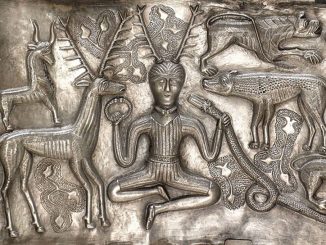Experts believe that delicate jewelry such as gold earrings and gold pendants help protect the girl in the afterlife.

Gold jewelry set dating back 1,800 years. Photo: Emil Aladjem/Israel Antiquities Authority
A set of ancient gold jewelry in a tomb near Jerusalem was displayed for the first time at the 48th Archaeological Congress organized by the Israel Antiquities Authority, the Israel Exploration Association and the Israel Archaeological Society in Jerusalem on March 3. /4. They were discovered more than 50 years ago, but had never been displayed to the public until the congress.
Adorned with the symbol of the Roman goddess Luna, this 1,800-year-old jewelry set is intended to ward off evil spirits and protect a young girl in the afterlife. The jewelry set includes gold earrings, hairpin, gold pendant, gold beads, red carnelian beads and glass beads.
Experts found them in a lead coffin at a Roman burial site on Mount Scopus, northeast of Jerusalem, in 1971. It seems that relatives placed these delicate items next to the girl’s body. young, or simply the girl was wearing jewelry when she was buried.
The jewelry set helps scientists understand more about the period when this area was ruled by the Roman empire. For more than a century, from 6 to 132, it was known as the Roman province of Judea. This period also had events such as the crucifixion of Jesus and the emergence of Christianity.
Roman rule ended in chaos and bloodshed, but left a cultural impact. The jewelry set in Jerusalem is one of the evidences that shows this. Some items, such as necklaces with crescent moon pendants, bear the symbol of Luna – the Roman goddess of the Moon.
The historical context of the tomb suggests that this may have been a burial place for newcomers to the city. They came from elsewhere in the Roman empire and were not Christians. Researchers believe it is likely that the jewelry was buried nearby to protect the deceased from bad spirits that plagued them in the afterlife.


